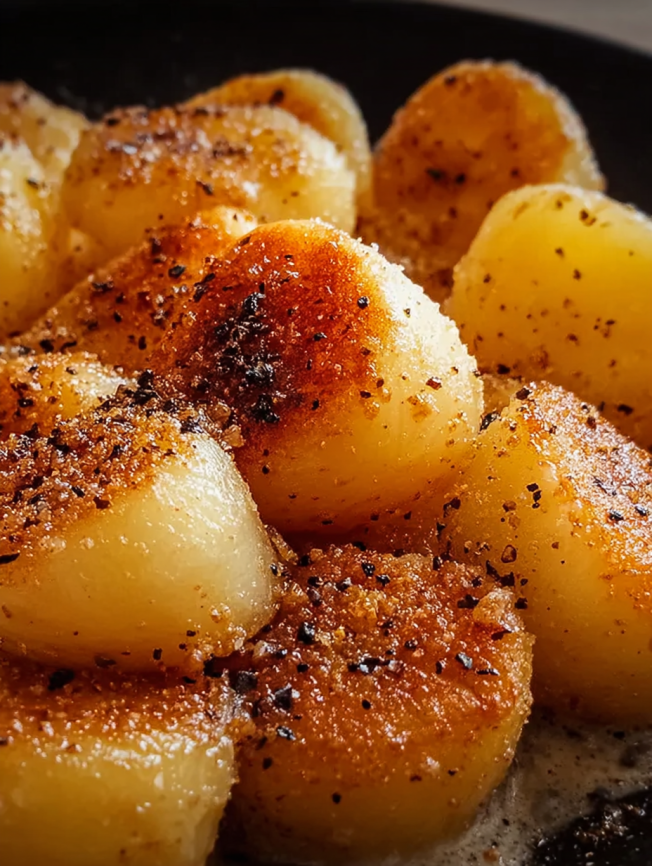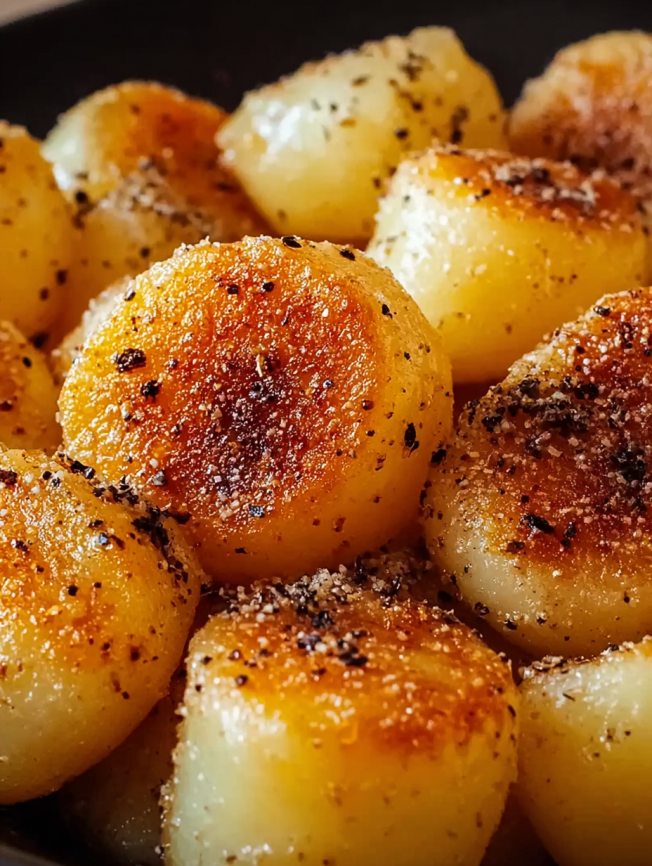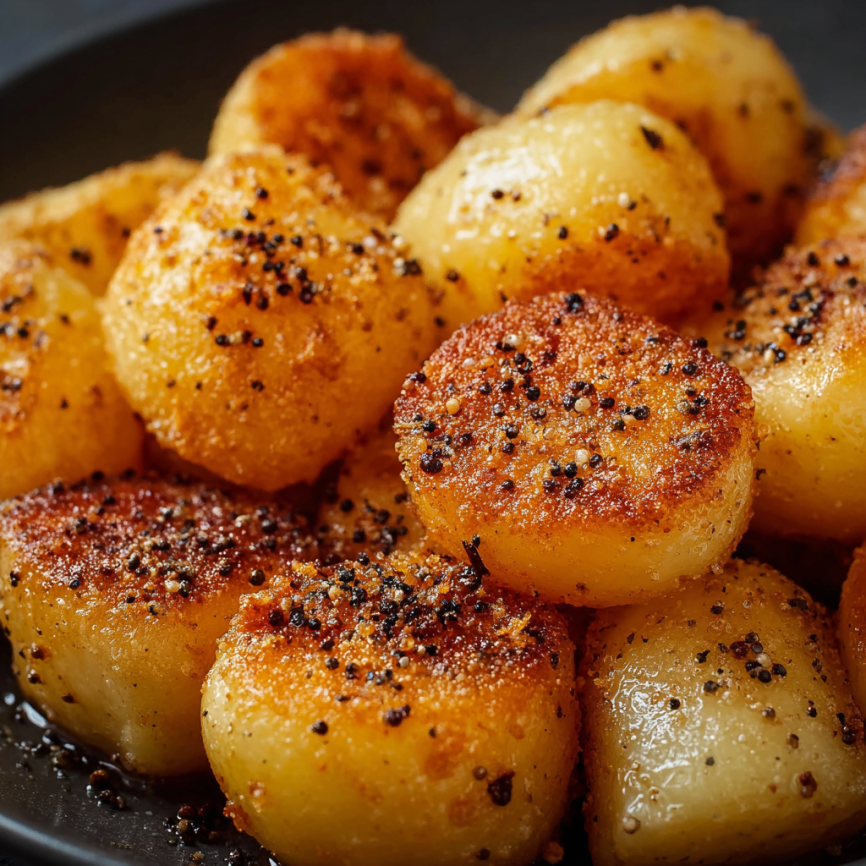Total Time: 1 hour | Yield: 4 servings | Diet: Vegetarian
Every time I smell buttery breadcrumbs sizzling in a pan, I’m transported back to my childhood visits to Poland, where my babcia would prepare steaming bowls of kopytka on chilly autumn evenings. These humble potato dumplings, shaped like tiny hooves (which is what “kopytka” means in Polish), represent the heart of Eastern European comfort cooking. Unlike their Italian gnocchi cousins, kopytka have their own unique character – slightly denser, wonderfully satisfying, and always served with that signature crown of golden breadcrumbs that makes them truly special.
Why This Kopytka Recipe Will Become Your New Favorite
Authentic Polish Heritage
This recipe captures the essence of traditional Polish home cooking, where simple ingredients transform into something extraordinary. Passed down through generations, kopytka represent the resourcefulness of Polish cuisine – creating hearty, filling meals from pantry staples. Furthermore, the technique has remained virtually unchanged for centuries, proving its timeless appeal.
Incredibly Satisfying and Hearty
These potato dumplings offer the perfect balance of comfort and nourishment. Each piece provides substantial satisfaction, making kopytka an ideal main course for cold days or when you need something truly filling. Additionally, the golden breadcrumb topping adds delightful texture contrast that elevates the entire dish.
Budget-Friendly Family Meal
With ingredients that cost just a few dollars, kopytka can easily feed a hungry family without breaking the bank. Moreover, leftovers reheat beautifully, making them perfect for meal planning and busy weeknight dinners.
Simple Yet Rewarding to Make
While the process requires some patience, the actual techniques are straightforward and forgiving. Even novice cooks can master kopytka with a little practice. Best of all, the hands-on preparation can be quite therapeutic and connects you to generations of Polish home cooks.
Essential Ingredients for Perfect Kopytka
Main Dumpling Components
- 1 kg floury potatoes (varieties like Bintje, Irys, or Russet work beautifully)
- 250 g all-purpose wheat flour (crucial for achieving proper dough consistency)
- 1 large egg (provides elasticity and helps with shaping)
- 1 teaspoon fine salt (enhances the natural potato flavor)
Golden Breadcrumb Topping
- 50 g unsalted butter (for creating the signature breadcrumb mixture)
- 100 g fine breadcrumbs (preferably homemade for best flavor)
Serving Enhancement Options
Consider preparing these traditional accompaniments:
- Crispy bacon bits for added richness
- Sour cream for tangy contrast
- Caramelized onions for sweetness
- Fresh dill for aromatic freshness
Step-by-Step Instructions for Success
Preparing the Potato Base
- Select and prepare potatoes by choosing high-starch varieties for the fluffiest texture. Peel them thoroughly and cut into uniform small pieces to ensure even cooking.
- Boil the potatoes in generously salted water for 20-25 minutes until completely tender when pierced with a fork. Proper cooking is crucial – undercooked potatoes will create lumpy dough.
- Drain thoroughly and allow the potatoes to cool completely before proceeding. This step prevents the egg from cooking when mixed into the dough.
Creating the Perfect Dough
- Mash the potatoes until completely smooth using a potato ricer or fine-mesh sieve. Avoid using electric mixers, which can make the potatoes gluey.
- Combine ingredients gradually by creating a well in the mashed potatoes. Add the egg and salt first, then incorporate flour little by little until a soft, pliable dough forms.
- Knead gently just until the dough comes together. Overworking will result in tough, dense dumplings.
Shaping the Kopytka
- Divide the dough into manageable portions on a floured work surface.
- Roll into logs approximately 2 cm thick, working with one portion at a time while keeping the rest covered.
- Cut into pieces 3-4 cm long using a knife or bench scraper. The traditional hoof shape will form naturally during cooking.
Cooking and Finishing
- Bring salted water to a gentle boil in a large pot – vigorous boiling can break apart the dumplings.
- Cook in small batches to prevent overcrowding. Add kopytka to the water and wait for them to float to the surface.
- Continue cooking for an additional 2-3 minutes after they float, ensuring they’re cooked through.
- Prepare the breadcrumb topping by melting butter in a large skillet over medium heat. Add breadcrumbs and stir constantly until golden brown and fragrant.
- Combine and serve by gently folding the cooked kopytka into the breadcrumb mixture until well coated.

Creative Serving Suggestions
Traditional Polish Style
Serve kopytka immediately while hot, topped generously with the golden breadcrumb mixture. Accompany with a dollop of sour cream and a sprinkle of fresh dill. This classic preparation highlights the comforting simplicity that makes kopytka so beloved.
Modern Variations
Transform leftover kopytka into a breakfast dish by pan-frying them until crispy and serving with scrambled eggs. Alternatively, toss them with sautéed mushrooms and caramelized onions for an elevated weeknight dinner.
Seasonal Adaptations
During summer months, serve kopytka at room temperature as a potato salad alternative, dressed with olive oil, herbs, and cherry tomatoes. In winter, create a heartier version by adding crispy bacon or kielbasa to the breadcrumb mixture.
Delicious Recipe Variations
Savory Herb Kopytka
Incorporate finely chopped fresh herbs like parsley, chives, or dill directly into the dough for added flavor complexity. This variation pairs beautifully with simple butter and sour cream.
Sweet Dessert Version
Replace the salt with sugar and serve with cinnamon butter, fresh berries, or a drizzle of honey. This traditional dessert variation is popular during Polish holidays and special occasions.
Gluten-Free Alternative
Substitute wheat flour with a combination of rice flour and potato starch for those avoiding gluten. The texture will be slightly different but equally satisfying.
Make-Ahead Tips for Convenience
Advance Preparation Options
Cook and mash the potatoes up to one day ahead, storing them covered in the refrigerator. Bring to room temperature before adding other ingredients. This technique actually improves the texture by allowing excess moisture to evaporate.
Freezing Fresh Kopytka
Shape the uncooked kopytka and arrange them on parchment-lined baking sheets without touching. Freeze until solid, then transfer to freezer bags. Frozen kopytka can be cooked directly from the freezer with just an extra minute or two of cooking time.
Storing Leftovers
Cooked kopytka keep well in the refrigerator for up to three days in an airtight container. Reheat gently in a skillet with a little butter, or microwave with a splash of water to prevent drying out.
Essential Notes for Perfect Results
Potato Selection Wisdom
Choose floury potatoes with high starch content for the lightest, fluffiest kopytka. Waxy potatoes contain too much moisture and will create dense, heavy dumplings. Additionally, cooking potatoes with skins on helps prevent water absorption.
Temperature and Texture Tips
Work with completely cooled potatoes to prevent the egg from cooking prematurely. However, don’t let them get cold enough to become difficult to mash smoothly.
Flour Integration Secrets
Add flour gradually and use only enough to bring the dough together. The dough should be soft and slightly sticky – too much flour creates tough kopytka that lack the traditional tender texture.
Cooking Water Guidelines
Use generously salted water (it should taste like seawater) to season the kopytka from within. Moreover, maintain a gentle boil rather than vigorous bubbling to prevent the dumplings from breaking apart.

Frequently Asked Questions
How do I prevent my kopytka from falling apart during cooking? Ensure your dough isn’t too wet by using completely cooled, well-drained potatoes. Additionally, cook them in gently boiling water rather than a rolling boil, and handle them carefully when removing from the pot.
Can I make kopytka ahead of time for a dinner party? Absolutely! Shape the kopytka several hours ahead and keep them covered on a floured surface. You can also cook them earlier in the day and reheat them gently in the breadcrumb mixture just before serving.
What’s the difference between kopytka and gnocchi? While both are potato dumplings, kopytka are typically larger, denser, and always served with breadcrumbs. They also use a higher ratio of flour to potatoes, giving them their characteristic hearty texture.
Why do my kopytka turn out too dense? This usually happens from overworking the dough or using the wrong type of potatoes. Next time, handle the dough minimally and ensure you’re using high-starch potatoes that have been properly drained and cooled.
Can I freeze cooked kopytka? Yes, cooked kopytka freeze well for up to two months. Freeze them in single portions and reheat directly from frozen in a skillet with butter until heated through and slightly crispy.
What traditional Polish dishes pair well with kopytka? Kopytka complement dishes like bigos (sauerkraut stew), kotlety schabowe (breaded pork cutlets), or simply served alongside Polish sausage and sauerkraut for an authentic meal.
Recipe Summary:
- Prep Time: 30 minutes
- Cook Time: 30 minutes
- Total Time: 1 hour
- Servings: 4 generous portions
- Cuisine: Polish
- Method: Boiling and pan-frying
- Category: Main course
Nutrition per serving: 250 calories | 35g carbs | 6g protein | 10g fat | 3g fiber | 500mg sodium

